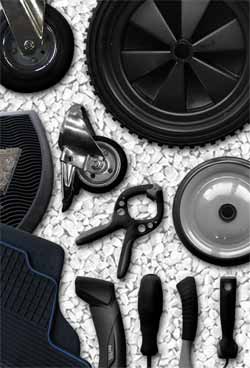Quality products from rubber residues

Elastomeric powders can be used in a variety of ways in high-quality materials. <br>© Fraunhofer UMSICHT<br>
Each year throughout the world, up to 22 million tons of rubber are processed and a large portion of it goes into the production of vehicle tires. Once the products reach the end of their useful life, they typically land in the incinerator. In the best case, the waste rubber is recycled into secondary products.
Ground to powder, the rubber residues can be found, for example, in the floor coverings used at sports arenas and playgrounds, and in doormats. But until now, the appropriate techniques for producing high-quality materials from these recyclables did not exist. Researchers at the Fraunhofer Institute for Environmental, Safety and Energy Technology UMSICHT in Oberhausen recently succeeded in optimizing the recycling of rubber waste materials. They have developed a material that can be processed into high-quality products, like wheel and splashguard covers, handles, knobs and steerable castors.
The new plastic compounds are called elastomer powder modified thermoplastics or EPMT for short. They are comprised of rubber residues crushed into elastomer powder that are blended with thermoplastics. “In the first step, the rubber residues – that can be meter-long rubber pieces are granulated to three-millimeter large particles. The particles are cooled with liquid nitrogen and then ground into elastomeric powders. This is then conducted to the melt-mix process with thermoplastics and additives. Here we use, for example, polypropylene as a thermoplastic material,” as Dr. Holger Wack, scientist at UMSICHT, explains the production process. Working jointly with his colleagues Damian Hintemann and Nina Kloster, the trio collaborates on the “EXIST Research Transfer” project sponsored by the Federal Ministry for Economics and Technology BMWi, where they work meticulously on various recipes for new blends of materials that are already protected by patent and trademark rights.
Variable material properties
The compound stands out from a number of different perspectives: The crushing of rubber waste is more environmentally-friendly and resource-efficient than producing new rubber products – an important aspect in view of the rising costs of energy and raw materials. “EPMT may contain up to 80 percent residual rubber; only 20 percent is made up by the thermoplastics,” says Wack. EPMT can be easily processed in injection molding and extrusion machines, and in turn, these products are themselves recyclable. The clou: The physical and mechanical material properties of the substance – like elasticity, breaking strain and hardness – can be individually modified, according to the customer’s wishes.
Altogether, three basic recipes have been developed that collectively can be processed on the large technical production machines. The researchers are capable of producing 100 to 350 kilograms of EPMT per hour. Spurred on by this success, Wack and both of his colleagues founded Ruhr Compounds GmbH. In addition to the production and the sale of EPMT materials, this Fraunhofer spin-off offers custom-made service packages: “We determine which of the customer’s materials can be replaced by EPMT, develop customized recipes and also take into account the settings required at our customers‘ industrial facilities,” says the scientist.
The widest array of industries will benefit from the expertise of these professionals: processors of thermoplastic elastomers can obtain EPMT and further process it into products. Industrial companies whose work involves elastomers – such as the industrial and construction sectors, or car-makers and athletics – could recycle these products, make EPMT from them, incorporate them into their existing products and thereby close the materials cycle.
Nike tests EPMT
In the “Re-use a Shoe” project, sports gear maker Nike has been collecting used sneakers for a while now, recycled their soles and under the label “Nike Grind”, reprocessed them as filler material for sports arenas and running track surfaces. The EPMT compound of the Fraunhofer researchers enables Nike to place new products on the market. As one of its official promotional partners, “Tim Green Gifts” created the first EPMT-based promotional articles under the “Nike Grind” brand, like frisbees, shoehorns and boomerangs. Discussions about using new EPMT compounds in the original portfolio, such as zippers, bag bases and sports equipment, have also been initiated. “We are extremely excited about this collaboration,” says Wack.
Media Contact
All latest news from the category: Materials Sciences
Materials management deals with the research, development, manufacturing and processing of raw and industrial materials. Key aspects here are biological and medical issues, which play an increasingly important role in this field.
innovations-report offers in-depth articles related to the development and application of materials and the structure and properties of new materials.
Newest articles

AI to improve brain cancer diagnosis, monitoring, treatment
Recommendations published in The Lancet Oncology call for good clinical practice of new technologies to modernize decades-old standard of care for brain cancer patients. An international, multidisciplinary team of leading…

AI tool ‘sees’ cancer gene signatures in biopsy images
AI tool reads biopsy images… To determine the type and severity of a cancer, pathologists typically analyze thin slices of a tumor biopsy under a microscope. But to figure out…

Skull bone marrow expands throughout life
…and remains healthy during aging. Blood vessels and stromal cells in the bone marrow create an ideal environment for hematopoietic stem cells to continuously produce all blood cells. During aging,…


